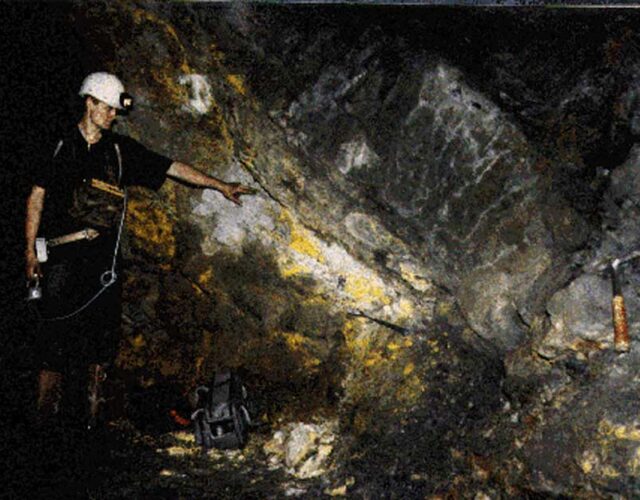What a bizarre site in Africa—a 1.7-billion-year-old, completely natural nuclear reactor—says about the future of energy production on planet Earth.
The Science History Institute has teamed up with New York Times best-selling author Sam Kean to bring a second history of science podcast to our listeners. The Disappearing Spoon tells little-known stories from our scientific past—from the shocking way the smallpox vaccine was transported around the world to why we don’t have a birth control pill for men. These topsy-turvy science tales, some of which have never made it into history books, are surprisingly powerful and insightful.
Credits
Host: Sam Kean
Senior Producer: Mariel Carr
Producer: Rigoberto Hernandez
Audio Engineer: Jonathan Pfeffer
Transcript
When the French authorities learned about the missing uranium, one terrible thought raced through their minds. That someone had stolen it, to make rogue atomic bombs.
They had good reason to worry. It was the early 1970s, a time of widespread terrorism around the world. During one eighteen-month stretch, the FBI recorded 2,500 bombings in the United States alone—five every day. Europe was just as bad. And it all culminated in the awful massacres at the 1972 Olympics.
So yeah, people were paranoid about terrorists. Then French officials found out that uranium was missing from a mine of theirs in Africa. They naturally assumed that some terrorist group had upped the ante and stolen it. Enough was missing to make six atomic bombs.
They could not have been more wrong. Terrorists hadn’t stolen the uranium at all. No one had. The truth was even wilder. In reality, the French had just uncovered evidence of the world’s first and only natural nuclear reactor.
The uranium in question came from a mine called Oklo. It’s located in the former French colony of Gabon in Western Africa.
The discrepancy at Oklo that first caught the French authorities’ eyes was tiny. Uranium comes in two main types, uranium-235 and uranium-238. Each type has the same number of protons, but a different number of neutrons. Uranium-238 has three extra.
Now, uranium-238 is far more common. It makes up over 99 percent of all uranium. Uranium-235 makes up just 0.720 (point-seven-two-zero) percent of uranium. And that percent is the same everywhere in the world.
Except at Oklo. In 1972, French authorities noticed that things were a tiny bit off. Instead of uranium-235 being 0.720 (point-seven-two-zero) percent, the concentration was 0.717 (point-seven-one-seven) percent. That’s a difference of three one-hundred-thousandths. If you were measuring the length of a football field, that’s a discrepancy of a tenth of an inch.
Other parts of Oklo showed somewhat larger discrepancies—down to 0.44 (point-four-four) percent. But even then, you might be wondering, who cares? That’s so tiny.
Well, they did care. First, that missing bit of uranium-235 mattered because, of the two main types, uranium-235 is the dangerous one—the one that goes into bombs. And however small the percentage discrepancy, there were so many tons of uranium overall at Oklo that the missing bits added up fast—enough to make six bombs. So yeah, the missing uranium-235 was terrifying.
But once they looked closer, French authorities noticed something odd. Wherever they found lower percentages of uranium-235, the surrounding rock also looked scorched. Burned and black, like someone took a flamethrower to it. What could have produced so much heat?
More importantly, the sites with the missing uranium had not been disturbed for over a billion years. Which ruled out the idea that terrorists had dug up uranium. But then where had it gone? And what could have scorched the rocks?
Not surprisingly, several fringe groups rushed into this vacuum of uncertainty. They began promoting Oklo as quote-unquote “evidence” of antimatter meteorites or crash-landings by ancient aliens in star-cruisers.
Meanwhile, the scientific community began to ponder another idea—one that at first might sound no less crazy than alien star-cruisers. But as Sherlock Holmes said, “Once you eliminate the impossible, whatever remains, no matter how improbable, must be the truth.” And the truth is, that Oklo was a natural nuclear reactor.
The reactor arose due to a set of special circumstances 1.7 billion years ago. At the time, Oklo was a mudflat. The soil was soft clay with some dilute uranium minerals mixed in. Then, for some reason, the site started flooding on a regular basis. Each time, some of the uranium would dissolve in the water and trickle down into underground pools.
Those pools contained algae, or pond scum. And when the uranium water trickled down, the algae pond scum would absorb it—and thereby concentrate it.
When the algae died, their tiny carcasses would drift down to the bottom of the underground ponds and pile up—which concentrated the uranium more. Eventually, the uranium grew concentrated enough to reach a critical mass—the point at which a chain reaction starts. These algae were the world’s first nuclear engineers.
But, it takes more than a critical mass to get a chain reaction going. It also takes water.
A uranium-235 atom will split in half—or fission—if it absorbs a neutron. And as it splits, that uranium-235 spits out more neutrons. These neutrons fly off and hit other uranium-235 atoms and cause them to split. That second round of splitting then releases more neutrons—which fly off and cause more splitting, and so on. That’s what we mean by a chain reaction. One splitting atom becomes two, two becomes four, four becomes eight and sixteen, and so on.
But there’s a caveat here. When a uranium atom splits in half, the neutrons fly out at absolutely blistering speeds—8400 miles per second. That’s too fast for a uranium-235 atom to absorb. Neutrons moving that fast are like stones skipped across a pond. They just bounce off and keep going. The uranium atoms cannot absorb them, and when uranium atoms can’t absorb neutrons, a chain reaction never really gets going.
So, for a chain reaction, you have to slow neutrons down. And that’s what water does—slows neutrons down. The speeding neutrons smack into water molecules and lose momentum, until they’re traveling more slowly. Mind you, these neutrons are still going darn fast, over a mile per second. But at that speed, uranium atoms can snag and absorb them. Then the atom splits and releases more neutrons and kicks off a chain reaction. That’s why water is important.
Another caveat to take into account is the percentage of uranium-235. Again, uranium-235 currently makes up 0.720 (point-seven-two-zero) percent of natural ores; that’s 1 in every 140 atoms. But that percentage has changed over time.
Our solar system formed 4½ billion years ago after a big horrendous space kablooie—a supernova explosion. That explosion created most of the elements on the periodic table, including uranium-235 and -238. And right after the big kablooie, the relative percentage of uranium-235 was high. Instead of being 1 in 140 atoms, it was 1 in 6 atoms—17 percent.
But uranium-235 is unstable. It decays naturally. In particular, it decays far faster than uranium-238. So over the eons, the relative percentage of uranium-235 kept sinking. It dropped from 17 percent to 16 percent, then 15 and 14, and so on.
1.7 billion years ago, the level of uranium-235 was 3 percent. And that’s an important threshold. To get a chain reaction going, you need at least 3 percent uranium-235. That’s in fact why modern nuclear engineers have to enrich uranium—to boost the concentration of U-235 over the 3 percent mark. But 1.7 billion years ago, no enrichment was necessary. Natural uranium was strong enough.
Overall, then, that’s how French scientists explained the natural atomic reactor in Oklo. Water dissolved the uranium out of the clay on the surface, and it trickled down into underground pools. There, pond scum soaked it up and concentrated it. The water also slowed neutrons down enough to allow a chain reaction to start, and there was just enough uranium-235—3 percent—to keep the chain reaction going.
On average, the Oklo reactor provided 100 kW of power—enough to run 800 big-screen TVs, 225 computers, or 25 clothes dryers. All driven by pond scum and water.
And there’s more. Uranium fission produces heat—which explained the scorched black rocks the scientists found. But how comes there’s not a big black crater in Oklo today?
Well, because whenever the underground uranium got hot enough, the water around it boiled away. With no water, the neutrons started flying too fast for the atoms to absorb. So the chain reaction grinded to a halt, and new heat- and energy-production stopped.
Only when the uranium cooled down enough did water trickle back in—which slowed the neutrons again and restarted the reactor. In other words, this reactor was completely self-regulating. It was a nuclear Old Faithful, with on/off cycles of three hours. And it ran for 150,000 years, consuming 10,000 pounds of uranium before it finally petered out.
Pretty darn amazing.
Still, you might be left wondering something. If uranium concentrations were so much higher in the past, why aren’t there other Oklos, in other places around the world? Well, there’s a simple answer to that—a simple answer with some profound consequences for the future of human beings on this planet.
If the relative percentage of uranium-235 was higher on Earth in the past, why aren’t there Oklos all over the place? The answer involves oxygen.
Readers of my book Caesar’s Last Breath might remember that the O-2 oxygen molecule was a surprisingly late addition to Earth’s history. Oxygen gas is simply too reactive to exist long in a free state. Instead, it has to be continuously generated by living things. Like algae, which release oxygen as a byproduct of photosynthesis.
Because algae are aquatic, they released oxygen into the water around them. There, oxygen glommed onto dissolved iron atoms to form a rusty precipitate. But 2.3 billion years ago, something shifted. There were suddenly so many algae pumping out so much oxygen that the iron in the ocean ran low. At this point, free oxygen began accumulating in the water.
This buildup of oxygen in the water was crucial. A few minutes ago, I mentioned that uranium from the clay mudflats at Oklo was dissolving in water. But that was a bit of a fudge. Uranium does not dissolve in pure, distilled water.
But oxygen changes the chemistry of water, and allows water to dissolve uranium easily. This allowed the uranium at Oklo to slip out of the clay and trickle underground. So the algae were not only concentrating uranium, they were producing the oxygen that freed the uranium in the first place. They really were nuclear engineers.
Overall, then, oxygen helps explains the lack of other Oklos. Even though the percentage of uranium-235 was higher billions of years ago, the lack of oxygen in the water back then killed the possibility of concentrating that uranium into a critical mass. Only around 1.7 billion years ago was there enough oxygen. And after 1.7 billion years, the constantly dwindling percentage of uranium-235 on Earth sunk too low for a chain reaction to sustain itself. Oklo was a perfect storm in terms of available materials, and especially timing.
And again, there’s more! The free oxygen that algae were producing eventually started to accumulate not only in the water but in the air.
This buildup of atmospheric oxygen had all sorts of consequences—including, eventually, the production of staggeringly large insects. You can hear about these insects in a short bonus episode at patreon.com/disappearingspoon. We’re talking millipedes a yard long; dragonflies the size of seagulls; spiders as wide as car tires. It’s wild stuff. That’s patreon.com/disappearingspoon.
This buildup of oxygen also had profound consequences for another energy source on Earth—fire.
Think about fire for a moment. What things do you need to start a fire? First, fuel, something to burn. Then, a spark of energy, to kick things off. Finally, oxygen.
But again, free oxygen didn’t exist for most of Earth’s history. Which means there wasn’t any fire, either. Really. Even volcanoes and lightning strikes couldn’t ignite anything without oxygen. We in fact see zero evidence of fire in the geological record until a few hundred million years ago, when the first black charcoal appears. That’s the point when oxygen levels finally crept up high enough to sustain fire.
Which sounds kind of crazy. When it comes to energy, we think about fire as ancient, primordial. It’s deep and profound. But not really. Fire is a Johnny-come-lately.
Which gets me thinking. Fire seems comforting in part because it seems ancient—our ancestors cooking around campfires and such. Meanwhile, atomic power seems scary and alienating, in part because it seems unnatural. But—it’s not. Mother Nature fired up the first atomic reactors a billion-plus years before fire ever existed.
And consider this. The ultimate source of all life on Earth is the sun—which also runs on atomic power. All stars do. And stars are far more widespread than fire in the cosmos. In fact, we don’t know of a single other spot in the universe where any fire has ever burned. Anywhere. Meanwhile, atomic-powered stars are everywhere.
All of which should maybe influence how we think about atomic power. Now, I’ll admit my bias here: I’m kinda pro–nuclear power. Partly because I don’t see radioactivity as scary or artificial. I mean, kitty litter is radioactive. So are granite countertops. Heck, even bananas are radioactive. Radioactivity is natural; it’s all around us.
Now, in saying that, I’m not being cavalier about atomic power plants. Dealing with radioactive waste is a serious challenge. Accidents are real problems, too. Chernobyl and Fukushima were awful. People died, people got cancer, and the surrounding land was poisoned. It’s scary stuff.
But do you know what’s even scarier? Fossil fuels.
Let’s look at the safety record of nuclear power—deaths from mining, accidents, etc. For every one person that dies due to atomic power, coal kills 344 people. Oil kills 258. Even biofuels like ethanol kill 64. So the stats are clear. In terms of sheer death, nuclear power is safer.
And that doesn’t even consider the destruction wrought by greenhouse gases. For every ton of greenhouse gas released by atomic power plants, burning coal releases 273 tons. Burning oil releases 240 more. Heck, wind and solar power release more greenhouse gases than atomic power.
To me, our collective fear of atomic power looks an awful lot like some people’s fear of flying. Plane crashes are dramatic and scary. There are fireballs and explosions, and everyone onboard dies. They’re terrible.
But plane crashes are also rare. Meanwhile, car accidents happen all the time. They kill and maim thousands of people every day—every hour. But because all that death comes in ones and twos, in dribs and drabs, we discount it. It’s a cognitive bias.
The same goes for atomic power. Accidents like Chernobyl loom in our imaginations like horrible monsters—they overwhelm our minds. And again, they are scary. But why do we fret about them, yet yawn at the thousands of people that are killed every year by coal and oil? Not mention shrug at all the harm that burning fossil fuels does to the planet. It doesn’t make sense.
I suspect that, a hundred years from now, future generations will be baffled at how much we loathed and feared atomic power. And arguably, it’s more natural than burning fossil fuels. It’s more ancient, and more widespread than the fires needed to burn coal or oil. Meanwhile, even algae dabbled in nuclear power. Oklo may seem like a bizarre ancient relic. But it just might be the best path forward for planet Earth.




